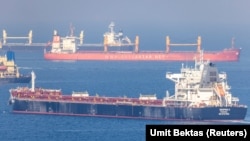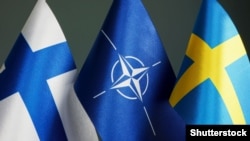
Welcome to Wider Europe, RFE/RL's new newsletter focusing on the key issues concerning the European Union, NATO, and other institutions and their relationship with the Western Balkans and Europe's eastern neighborhoods. To subscribe, click here.
I'm RFE/RL Europe Editor Rikard Jozwiak and this week I'm drilling down on two major issues: whether the EU's "solidarity lanes" will get enough grain out of Ukraine and whether the OSCE will be able to pass a 2023 budget despite Russian objections?
Brief #1: How To Get Grain Out Of Ukraine
What You Need To Know: On October 29, Russia suddenly announced that it was walking away from the UN-mediated Black Sea grain deal that since mid-July has allowed nearly 10 million tons of grain to reach the rest of the world from Ukrainian ports previously blocked due to the war.
The deal was welcomed, notably in the Horn of Africa where food shortages have been acute in recent months.
Only a few days later, however, Moscow said that it was coming back to the deal after talks with Ankara, which all along has played a crucial role in keeping sea lanes open.
With the deal up for renewal on November 19 and the extent of the fighting in Ukraine hard to predict, attention has shifted to the European Union to once again increase deliveries of Ukrainian products by land.
In May, when the Black Sea ships remained anchored, Brussels launched so-called "solidarity lanes" -- a logistical network between the EU and Ukraine that utilized rail, road, and inland waterways and involved the customs authorities of all the countries involved.
But can the capacity of these lanes, which are still in use, be increased? Just in case, that is, the grain deal breaks apart again.
Deep Background: The EU's solidarity lanes, which mainly go via Poland and Romania, have been fairly effective so far. From May until October 20, more than 14 million tons of agricultural products, notably wheat, corn, and sunflower oil, had been exported using the lanes, in addition to 15 million tons of nonfood items such as steel and oil.
Some political measures to speed up transit at the EU-Ukrainian border were taken immediately: for example, a zero VAT rate on Ukrainian goods that will last at least until the end of the year; exemptions from quotas and tariffs until June 2023; and the waiving of some phytosanitary checks on animal products not destined for the EU market.
Yet it is clear that transporting Ukrainian produce via the country's Black Sea ports in normal times is both cheaper and easier as ships can move larger quantities in one go. There have been calls for Brussels to invest substantially in infrastructure on its borders with Ukraine but also to fund and bolster the roads, railways, and waterways both in Ukraine and leading to Ukraine, which have been overwhelmed with lines sometimes several kilometers long.
Drilling Down
- In late September, at a background briefing, EU officials said they were starting to see capacity limits and bottlenecks at the two main lanes: the "Northern route," via Poland, and the "Danube route," leading to the port of Constanta in Romania. Hammering home why more investment was needed, waiting times could constitute 40 percent of total logistics costs, meaning that each ton of grain would become 80-90 euros ($79-89) more expensive to transport on land.
- The problem is that the EU budget for 2022 is already quite stretched and there is still no deal in place when it comes to Brussels' financial support for Ukraine in 2023. Yet it's been suggested that there are some smaller investments that could make a difference in the short term. To send EU customs personnel to front-line countries such as Poland to faster check the cargo is one option. Other possible solutions include more parking spaces for cargo traffic at the borders, additional lanes to separate commercial and private traffic, or even entirely new border crossings. Already this fall, the renovation of one crossing point along Ukraine's border with Slovakia is finished -- and two new crossings along the Ukraine-Romania border should soon be ready.
- EU officials also hope they can utilize some recent legislation: Ukraine's accession to the Convention on Common Transit on October 1. The treaty, which has already been in place between the EU and several non-EU European countries, creates common procedures for the international transit of goods and considerably reduces the amount of paperwork. EU officials have described Kyiv's joining as "a potential game changer" that can reduce customs times "from minutes to seconds." Yet they have also cautioned that a certain "phasing-in" period for Ukraine is needed and this could take some time.
- Other costlier options, such as dredging the Danube to increase river traffic and finding a solution to the different railway gauges used by Ukraine and Poland, might be useful, but could also take years. At least in the short-term, the "solidarity lanes" could lighten some of the burden in case the grain deal collapsed again -- but that's about it.
Brief #2: Is The Cash-Strapped OSCE Going To Survive?
What You Need To Know: By the end of the year, the Organization for Security and Cooperation in Europe (OSCE), must unanimously agree on its 2023 budget. But just like the 2022 budget, there is a risk that no deal will be reached. In 2022, the OSCE survived by juggling bills under emergency monthly allotments. The question is whether the Vienna-based organization can survive another year like this.
When OSCE Secretary-General Helga Schmid presented the 2023 budget to the 57 member countries of her organization in late October, she didn't mince her words. The OSCE is "in a dire state," she noted in her address and explained: "A decade of zero nominal growth has brought us to rock bottom. There is just no fat to trim. We are cutting bone now."
Deep Background: The proposed budget for next year is 144 million euros ($143 million) -- an increase of 4.6 percent or 6.4 million euros over the last agreed OSCE budget for 2021.
The money, which is provided by the participating states of the organization, goes toward employing the 550 people in the OSCE's various institutions and some of the 2,330 people working in the field.
The organization's field operations are mainly in the Western Balkans and Eastern Europe and could be dealing with anything from support of local law enforcement to early warning systems to conflict prevention. Most of the field operations also have staff members funded by their national administrations.
Officials in Vienna hope that the OSCE can be kept alive without a budget, instead surviving on projects financed by individual member states in cooperation with the OSCE and their staff. Yet the OSCE cautions that the lack of solid funding could mean that it might be harder to attract or retain qualified staff.
Drilling Down
- With inflation hitting double digits in Austria this year, the OSCE's number crunchers have calculated that Austria's real purchasing power has decreased 10 million euros ($10 million) in 2022 alone. This hits hardest when it comes to using parts of the Hofburg Palace, the former imperial winter residence of the Habsburgs, which has been the OSCE's headquarters for years. The rental costs have doubled in the last few years to well over 1 million euros per annum.
- Yet it is also clear that Russia, an OSCE member, is resisting passing the budget in its current form. When commenting on the 2023 proposal, Russia was, according to internal OSCE documents seen by RFE/RL, objecting to any references to the "war in Ukraine," or similar wording to that effect, in the nearly 500-page document.
- Moscow has objected to any rise in the budget for what is often referred to as the "third dimension" of the OSCE. This covers the activities of the Office for Democratic Institutions and Human Rights (ODIHR), which is known for its election monitoring. Also irking Russia is the so-called "Moscow mechanism," which allows a majority of OSCE states to send a mission of experts to another OSCE country to report on any problems there. Twice during the war in Ukraine, this mechanism has been triggered against Russia, much to the chagrin of the Kremlin -- once to probe potential war crimes committed in Ukraine and once to report on human rights violations inside Russia.
- When debating the proposal, the Russian delegation also noted that the soaring inflation was triggered by "the aggressive foreign policy of EU and NATO countries" and that they had to bear political as well as financial responsibility for their actions. In notes from a closed-door meeting that RFE/RL has seen, the Russian delegation responded to allegations that it was hijacking the budget discussions by noting that the issues were "better addressed to those delegations themselves," adding that "if those delegations would not have sent more weapons to the region, the situation would have improved months ago." Obviously, it was a clear reference to the United States and other European countries that have sent arms to Ukraine.
- Discussions on how to get the OSCE budget over the line are now in full swing in Vienna. Other options discussed include the possibility of agreeing a two-year budget so that these discussions won't resurface every year, or creating an automatic rollover process that requires consensus only for new commitments. The tricky part for the OSCE is if any of these options can get around the Russian objections.
Looking Ahead
There is a mini-plenary of the European Parliament in Brussels on November 9-10. The chamber will give the thumbs up to Croatia joining the open-border Schengen zone by January 1, 2023.
The final decision on Schengen entry will still need to be taken by EU member states, though, and is expected on December 9 when the bloc's interior ministers meet. For Croatia, all indications point to a green light. The case of Bulgaria and Romania, also hoping to join Schengen, might be a little trickier.
The European Parliament supports the pair, but the Netherlands is reportedly still reluctant. Bucharest and Sofia could well have to wait a little bit longer than Zagreb on this one.
On November 9, the European Commission is set to present its proposal for how to support Ukraine financially for the next year. As mentioned earlier in this newsletter, the proposal will suggest that Brussels provides 18 billion euros, equivalent to 1.5 billion euros per month in 2023.
The issue, as always when it comes to economic support, will be how to raise the money and if the cash should be dispersed in grants or loans or a combination of the two. Discussions are already under way among EU member states, but a deal has to be struck soon in time for the first budget disbursement in January 2023.
In another development previously mentioned here in the Wider Europe Briefing, it has now been confirmed that Swedish Prime Minister Ulf Kristersson will travel to the Turkish capital, Ankara, on November 8 to meet Turkish President Recep Tayyip Erdogan.
This comes after the NATO Secretary-General Jens Stoltenberg visited Turkey last week. In an interesting press conference in Ankara, Stoltenberg said that the Nordic NATO wannabees, Sweden and Finland, have done everything that Ankara had asked of them. Turkish Foreign Minister Mevlut Cavusoglu, however, acknowledged that progress had been made but that it still wasn't enough.
That's all for this week. Feel free to reach out to me on any of these issues on Twitter @RikardJozwiak or on e-mail at jozwiakr@rferl.org.
Until next time,
Rikard Jozwiak.
If you enjoyed this briefing and don't want to miss the next edition, subscribe here. It will be sent to your inbox every Monday.
And you can always reach us at newsletters@rferl.org.





